(一).选题背景:
什么是图像分类?它有哪些应用场合?图像分类任务是计算机视觉中的核心任务,其目标是根据图像信息中所反映的不同特征,把不同类别的图像区分开来。从已知的类别标签集合中为给定的输入图片选定一个类别标签。
它的难点在于:跨越“语义鸿沟”建立像素到语义的映射。还有就是视角、光照、尺度、遮挡、形变、背景杂波、类内形变、运动模糊、类别繁多等问题。
手机拍照、智能安防、自动驾驶等场景有广泛应用。从2012年AlexNet在ImageNet比赛夺冠以来,深度学习深刻推动了计算机视觉领域的发展,当前最先进的计算机视觉算法几乎都是深度学习相关的。深度神经网络可以逐层提取图像特征,并保持局部不变性,被广泛应用于分类、检测、分割、检索、识别、提升、重建等视觉任务中。
数据来源:kaggle,网址:https//www.kaggle.com/
(二).机器学习的实验步骤:
1. 关于数据
20类头饰的图像级—帽子、便帽。
3620幅训练图像、100幅验证图像
所以图像都是224*224*3的jpg格式
2. 导入库
try: # %tensorflow_version 仅存在于Colab中 %tensorflow_version 2.x except Exception: pass import warnings warnings.filterwarnings('ignore') import os, re, time, json import PIL.Image, PIL.ImageFont, PIL.ImageDraw import numpy as np import pandas as pd import tensorflow as tf from tensorflow import keras from tensorflow.keras.utils import image_dataset_from_directory from tensorflow.keras.applications.resnet50 import ResNet50 from matplotlib import pyplot as plt import tensorflow_datasets as tfds import matplotlib.pyplot as plt import seaborn as sns print("Tensorflow version " + tf.__version__)

# 常量 SPLIT_SIZE = .2 BATCH_SIZE = 64 IMG_SIZE = (224, 224)
EPOCHS=20
3. 加载数据
# 创建一些文件夹来存储培训和测试数据 TRAINING_DIR ="/tm /input/headgear-image-classification/train/" Valid_DIR="/tm/input/headgear-image-classification/valid/" TESTING_DIR ="/tm/input/headgear-image-classification/test/" train_data = image_dataset_from_directory(TRAINING_DIR, batch_size=BATCH_SIZE, image_size=IMG_SIZE ) val_data = image_dataset_from_directory(Valid_DIR, batch_size=BATCH_SIZE, image_size=IMG_SIZE ) test_data = image_dataset_from_directory(TESTING_DIR, batch_size=BATCH_SIZE, image_size=IMG_SIZE )

for images, labels in train_data.take(1): print(images.shape)

4. 探索数据
plt.figure(figsize=(15, 10)) for images, labels in train_data.take(1): for i in range(9): ax = plt.subplot(1, 9, i + 1) plt.imshow(images[i].numpy().astype("uint8")) plt.title(train_data.class_names[labels[i]], fontsize=10) plt.axis("off")
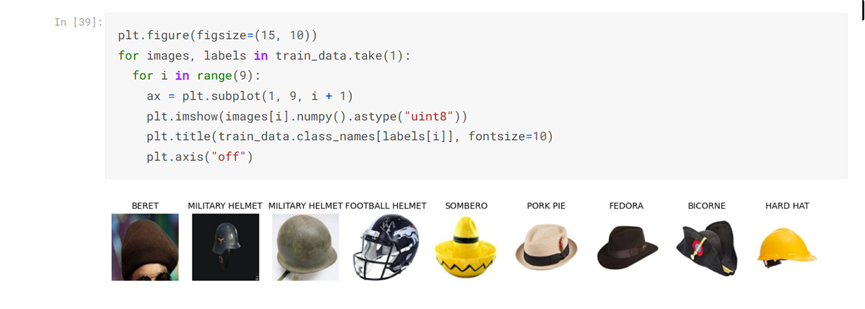
提取标签,如下行所示:
为train_data.class_names中的标签传递datal:中的每个标签
获取该标签文件夹中的文件名:OS . listdir(f " { data _ path }/{ label)")
获取文件名的计数:len().使用该标签名称和计数创建一个字典条目:label : len(
使用标签名称和计数创建字典条目:label : len(
label_counts = {label : len( os.listdir(f"{TRAINING_DIR}/{label}") ) for label in train_data.class_names }
NUM_CLASSES = len(label_counts)
#将字典转换为熊猫系列以便于操作label_counts = pd。 label_counts = pd.Series(label_counts) type(label_counts)

label_counts.sort_values(ascending=False, inplace=True)
plt.figure(figsize=(5,5)) ax = sns.barplot(x=label_counts.values[:50], y=label_counts.index[:50]) ax.set_title("Class distribution") plt.show()
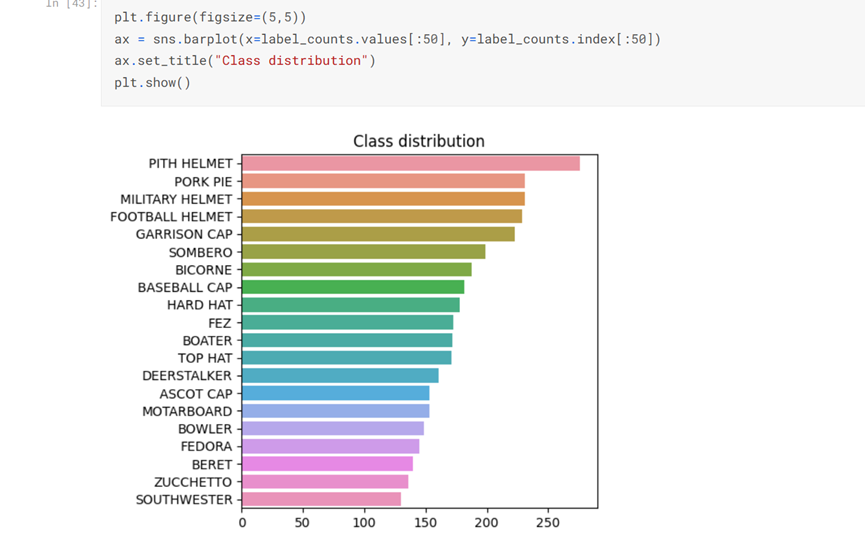
#少于150张图片的班级数量 label_counts[label_counts < 150]

# 从系列class _ NAMES = label _ counts . index . values CLASSES _ NAMES的第一列获取class _ NAMES CLASSES_NAMES = label_counts.index.values CLASSES_NAMES

5. 构建模型
由于我们有一个相对较小的数据集,其中有许多类,而且其中许多类只有很少的图像,因此,与从头开始训练模型相比,微调预训练模型将是一个更好的选择。让我们尝试一个ResNet58,看看它在我们的数据上的表现如何
预处理数据
使用Keras中ResNet50模型的函数preprocess_image_input对训练和验证集中的图像执行标准化。
def preprocess_image_input(image, label): image = tf.cast(image, tf.float32) image = tf.keras.applications.resnet50.preprocess_input(image) return image, label
train_data = train_data.map(preprocess_image_input)
val_data = val_data.map(preprocess_image_input)
定义网络
在Keras提供的ResNet50上执行迁移学习。
将预训练的imagenet权重加载到模型中。
选择保留ResNet50的所有层以及最终分类层。
''' Feature Extraction is performed by ResNet50 pretrained on imagenet weights. Input size is 224 x 224. ''' def feature_extractor(inputs): feature_extractor = tf.keras.applications.resnet.ResNet50(input_shape=(224, 224, 3), include_top=False, weights='imagenet')(inputs) return feature_extractor
''' Defines final dense layers and subsequent softmax layer for classification. ''' def classifier(inputs): x = tf.keras.layers.GlobalAveragePooling2D()(inputs) x = tf.keras.layers.Flatten()(x) x = tf.keras.layers.Dense(1024, activation="relu")(x) x = tf.keras.layers.Dense(512, activation="relu")(x) x = tf.keras.layers.Dense(NUM_CLASSES, activation="softmax", name="classification")(x) return x
''' Connect the feature extraction and "classifier" layers to build the model. ''' def final_model(inputs): resize = tf.keras.layers.UpSampling2D(size=(7,7))(inputs) resnet_feature_extractor = feature_extractor(inputs) classification_output = classifier(resnet_feature_extractor) return classification_output
''' Define the model and compile it. Use Stochastic Gradient Descent as the optimizer. Use Sparse Categorical CrossEntropy as the loss function. ''' def define_compile_model(): inputs = tf.keras.layers.Input(shape=(224,224,3)) classification_output = final_model(inputs) model = tf.keras.Model(inputs=inputs, outputs = classification_output) model.compile(optimizer= tf.keras.optimizers.Adam(), loss='sparse_categorical_crossentropy', metrics = ['accuracy']) return model
model = define_compile_model()
model.summary()
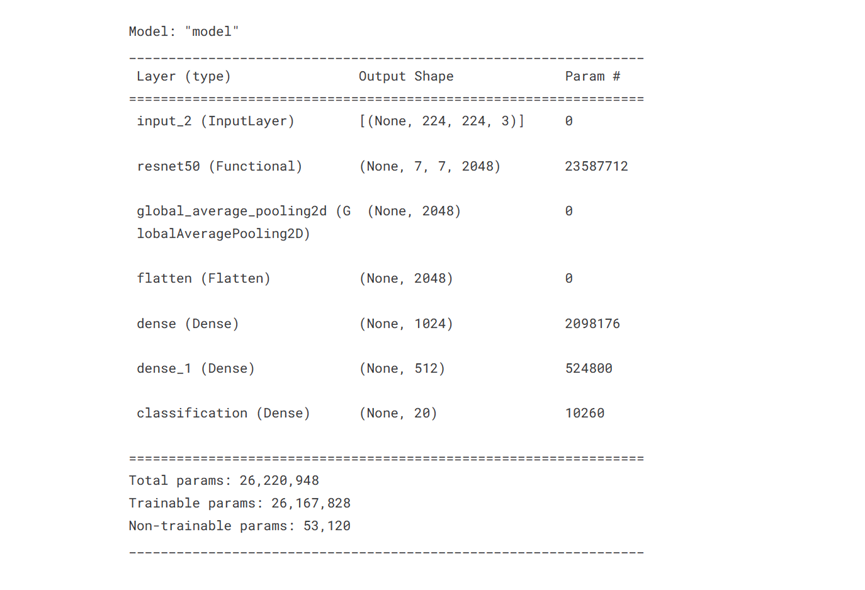
6. 训练模型
history = model.fit(train_data, epochs=EPOCHS, validation_data = val_data, batch_size=BATCH_SIZE)

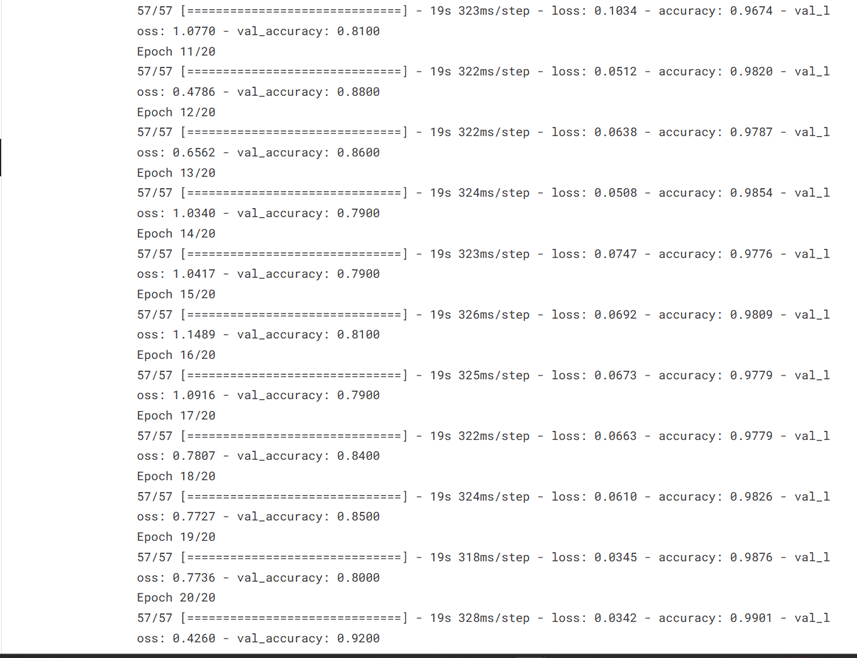
7定义一个函数来绘制训练数据
def tr_plot(tr_data): start_epoch=0 #绘制训练和验证数据tacc=tr数据。 tacc=tr_data.history['accuracy'] tloss=tr_data.history['loss'] vacc=tr_data.history['val_accuracy'] vloss=tr_data.history['val_loss'] tf1=tr_data.history['F1_score'] vf1=tr_data.history['val_F1_score'] Epoch_count=len(tacc)+ start_epoch Epochs=[] for i in range (start_epoch ,Epoch_count): Epochs.append(i+1) index_loss=np.argmin(vloss) #这是具有最低验证损失的时期 val_lowest=vloss[index_loss] index_acc=np.argmax(vacc) acc_highest=vacc[index_acc] indexf1=np.argmax(vf1) vf1_highest=vf1[indexf1] plt.style.use('fivethirtyeight') sc_label='best epoch= '+ str(index_loss+1 +start_epoch) vc_label='best epoch= '+ str(index_acc + 1+ start_epoch) f1_label='best epoch= '+ str(index_acc + 1+ start_epoch) fig,axes=plt.subplots(nrows=1, ncols=3, figsize=(25,10)) axes[0].plot(Epochs,tloss, 'r', label='Training loss') axes[0].plot(Epochs,vloss,'g',label='Validation loss' ) axes[0].scatter(index_loss+1 +start_epoch,val_lowest, s=150, c= 'blue', label=sc_label) axes[0].scatter(Epochs, tloss, s=100, c='red') axes[0].set_title('Training and Validation Loss') axes[0].set_xlabel('Epochs', fontsize=18) axes[0].set_ylabel('Loss', fontsize=18) axes[0].legend() axes[1].plot (Epochs,tacc,'r',label= 'Training Accuracy') axes[1].scatter(Epochs, tacc, s=100, c='red') axes[1].plot (Epochs,vacc,'g',label= 'Validation Accuracy') axes[1].scatter(index_acc+1 +start_epoch,acc_highest, s=150, c= 'blue', label=vc_label) axes[1].set_title('Training and Validation Accuracy') axes[1].set_xlabel('Epochs', fontsize=18) axes[1].set_ylabel('Accuracy', fontsize=18) axes[1].legend() axes[2].plot (Epochs,tf1,'r',label= 'Training F1 score') axes[2].plot (Epochs,vf1,'g',label= 'Validation F1 score') index_tf1=np.argmax(tf1) #这是tr最高的epoch tf1max=tf1[index_tf1] index_vf1=np.argmax(vf1) #这是f1得分最高的时期 vf1max=vf1[index_vf1] axes[2].scatter(index_vf1+1 +start_epoch,vf1max, s=150, c= 'blue', label=vc_label) axes[2].scatter(Epochs, tf1, s=100, c='red') axes[2].set_title('Training and Validation F1 score') axes[2].set_xlabel('Epochs', fontsize=18) axes[2].set_ylabel('F1 score', fontsize=18) axes[2].legend() plt.tight_layout plt.show() return
定义一个函数以将训练数据保存到
def save_history_to_csv(history,csvpath): trdict=history.history df=pd.DataFrame() df['Epoch']=list(np.arange(1, len(trdict['loss']) + 1 )) keys=list(trdict.keys()) for key in keys: data=list(trdict[key]) df[key]=data df.to_csv(csvpath, index=False)
8. 绘制损失和精度曲线
import matplotlib.pyplot as plt acc = history.history['accuracy'] val_acc = history.history['val_accuracy'] epochs = range(len(acc)) plt.plot(epochs, acc, 'r', label='Training accuracy') plt.plot(epochs, val_acc, 'b', label='Validation accuracy') plt.title('Training and validation accuracy') plt.legend(loc=0) plt.figure() plt.show()
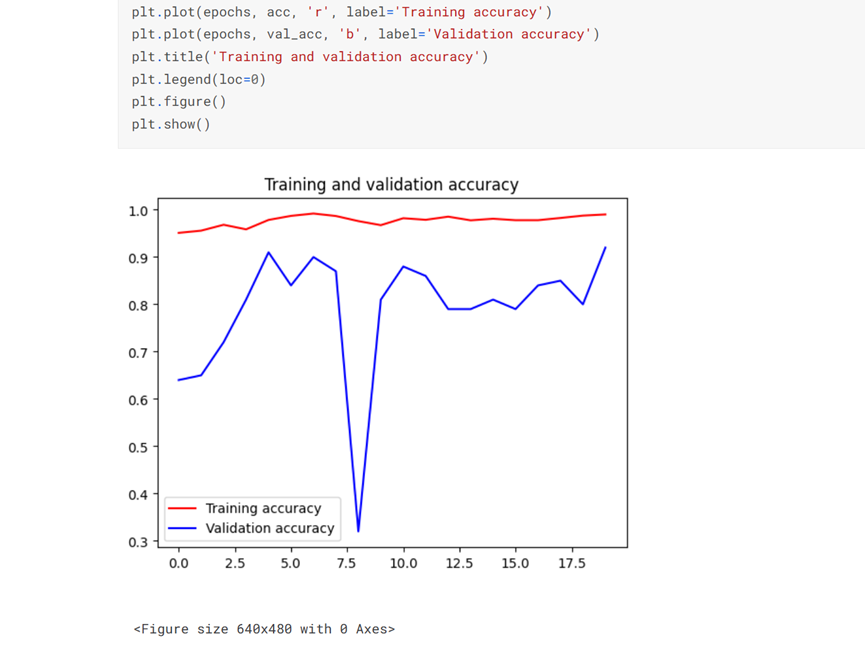
9. 评估模型
使用模型的计算损失和准确性指标。
loss, accuracy = model.evaluate(val_data, batch_size=BATCH_SIZE)

10. 测试模型
#获取图像的预测概率概率= model.predict(test_data) probabilities = model.predict(test_data) probabilities = np.argmax(probabilities, axis = 1) probabilities

plt.figure(figsize=(20, 10)) for images, labels in test_data.take(1): for i in range(5): ax = plt.subplot(1, 5, i + 1) plt.imshow(images[i].numpy().astype("uint8")) #获取真实标签和预测的类名 true_label = 'True Label: '+test_data.class_names[labels[i]] predicted_label = 'Predicted: '+test_data.class_names[probabilities[i]] #设置子情节的标题 plt.title(f"{true_label}\n{predicted_label}", fontsize=10) plt.axis("off")
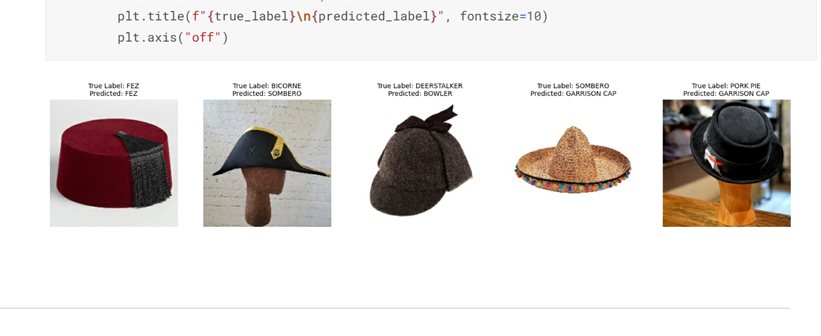
1 try: 2 # %tensorflow_version 仅存在于Colab中 3 %tensorflow_version 2.x 4 except Exception: 5 pass 6 7 import warnings 8 warnings.filterwarnings('ignore') 9 10 11 import os, re, time, json 12 import PIL.Image, PIL.ImageFont, PIL.ImageDraw 13 import numpy as np 14 import pandas as pd 15 16 import tensorflow as tf 17 from tensorflow import keras 18 from tensorflow.keras.utils import image_dataset_from_directory 19 from tensorflow.keras.applications.resnet50 import ResNet50 20 from matplotlib import pyplot as plt 21 import tensorflow_datasets as tfds 22 23 import matplotlib.pyplot as plt 24 import seaborn as sns 25 26 print("Tensorflow version " + tf.__version__) 27 28 #常量 29 SPLIT_SIZE = .2 30 BATCH_SIZE = 64 31 IMG_SIZE = (224, 224) 32 EPOCHS=20 33 34 # 创建一些文件夹来存储培训和测试数据 35 36 TRAINING_DIR ="/tm/input/headgear-image-classification/train/" 37 Valid_DIR="/tm/input/headgear-image-classification/valid/" 38 TESTING_DIR ="/tm/input/headgear-image-classification/test/" 39 40 train_data = image_dataset_from_directory(TRAINING_DIR, 41 batch_size=BATCH_SIZE, 42 image_size=IMG_SIZE 43 ) 44 45 val_data = image_dataset_from_directory(Valid_DIR, 46 batch_size=BATCH_SIZE, 47 image_size=IMG_SIZE 48 ) 49 50 test_data = image_dataset_from_directory(TESTING_DIR, 51 batch_size=BATCH_SIZE, 52 image_size=IMG_SIZE 53 ) 54 55 for images, labels in train_data.take(1): 56 print(images.shape) 57 58 plt.figure(figsize=(15, 10)) 59 for images, labels in train_data.take(1): 60 for i in range(9): 61 ax = plt.subplot(1, 9, i + 1) 62 plt.imshow(images[i].numpy().astype("uint8")) 63 plt.title(train_data.class_names[labels[i]], fontsize=10) 64 plt.axis("off") 65 66 label_counts = {label : len( os.listdir(f"{TRAINING_DIR}/{label}") ) for label in train_data.class_names } 67 NUM_CLASSES = len(label_counts) 68 69 #将字典转换为熊猫系列以便于操作label_counts = pd。 70 label_counts = pd.Series(label_counts) 71 type(label_counts) 72 73 label_counts.sort_values(ascending=False, inplace=True) 74 75 plt.figure(figsize=(5,5)) 76 ax = sns.barplot(x=label_counts.values[:50], y=label_counts.index[:50]) 77 ax.set_title("Class distribution") 78 plt.show() 79 80 #少于150张图片的班级数量 81 label_counts[label_counts < 150] 82 83 # 从系列class _ NAMES = label _ counts . index . values CLASSES _ NAMES的第一列获取class _ NAMES 84 CLASSES_NAMES = label_counts.index.values 85 CLASSES_NAMES 86 87 def preprocess_image_input(image, label): 88 image = tf.cast(image, tf.float32) 89 image = tf.keras.applications.resnet50.preprocess_input(image) 90 return image, label 91 92 train_data = train_data.map(preprocess_image_input) 93 val_data = val_data.map(preprocess_image_input) 94 95 ''' 96 Feature Extraction is performed by ResNet50 pretrained on imagenet weights. 97 Input size is 224 x 224. 98 ''' 99 def feature_extractor(inputs): 100 101 feature_extractor = tf.keras.applications.resnet.ResNet50(input_shape=(224, 224, 3), 102 include_top=False, 103 weights='imagenet')(inputs) 104 return feature_extractor 105 106 ''' 107 Defines final dense layers and subsequent softmax layer for classification. 108 ''' 109 def classifier(inputs): 110 x = tf.keras.layers.GlobalAveragePooling2D()(inputs) 111 x = tf.keras.layers.Flatten()(x) 112 x = tf.keras.layers.Dense(1024, activation="relu")(x) 113 x = tf.keras.layers.Dense(512, activation="relu")(x) 114 x = tf.keras.layers.Dense(NUM_CLASSES, activation="softmax", name="classification")(x) 115 return x 116 117 ''' 118 Connect the feature extraction and "classifier" layers to build the model. 119 ''' 120 def final_model(inputs): 121 122 resize = tf.keras.layers.UpSampling2D(size=(7,7))(inputs) 123 124 resnet_feature_extractor = feature_extractor(inputs) 125 classification_output = classifier(resnet_feature_extractor) 126 127 return classification_output 128 129 ''' 130 Define the model and compile it. 131 Use Stochastic Gradient Descent as the optimizer. 132 Use Sparse Categorical CrossEntropy as the loss function. 133 ''' 134 def define_compile_model(): 135 inputs = tf.keras.layers.Input(shape=(224,224,3)) 136 137 classification_output = final_model(inputs) 138 model = tf.keras.Model(inputs=inputs, outputs = classification_output) 139 140 model.compile(optimizer= tf.keras.optimizers.Adam(), 141 loss='sparse_categorical_crossentropy', 142 metrics = ['accuracy']) 143 144 return model 145 146 model = define_compile_model() 147 148 model.summary() 149 150 history = model.fit(train_data, 151 epochs=EPOCHS, 152 validation_data = val_data, 153 batch_size=BATCH_SIZE) 154 155 def tr_plot(tr_data): 156 start_epoch=0 157 #绘制训练和验证数据tacc=tr数据。 158 tacc=tr_data.history['accuracy'] 159 tloss=tr_data.history['loss'] 160 vacc=tr_data.history['val_accuracy'] 161 vloss=tr_data.history['val_loss'] 162 tf1=tr_data.history['F1_score'] 163 vf1=tr_data.history['val_F1_score'] 164 Epoch_count=len(tacc)+ start_epoch 165 Epochs=[] 166 for i in range (start_epoch ,Epoch_count): 167 Epochs.append(i+1) 168 index_loss=np.argmin(vloss) #这是具有最低验证损失的时期 169 val_lowest=vloss[index_loss] 170 index_acc=np.argmax(vacc) 171 acc_highest=vacc[index_acc] 172 indexf1=np.argmax(vf1) 173 vf1_highest=vf1[indexf1] 174 plt.style.use('fivethirtyeight') 175 sc_label='best epoch= '+ str(index_loss+1 +start_epoch) 176 vc_label='best epoch= '+ str(index_acc + 1+ start_epoch) 177 f1_label='best epoch= '+ str(index_acc + 1+ start_epoch) 178 fig,axes=plt.subplots(nrows=1, ncols=3, figsize=(25,10)) 179 axes[0].plot(Epochs,tloss, 'r', label='Training loss') 180 axes[0].plot(Epochs,vloss,'g',label='Validation loss' ) 181 axes[0].scatter(index_loss+1 +start_epoch,val_lowest, s=150, c= 'blue', label=sc_label) 182 axes[0].scatter(Epochs, tloss, s=100, c='red') 183 axes[0].set_title('Training and Validation Loss') 184 axes[0].set_xlabel('Epochs', fontsize=18) 185 axes[0].set_ylabel('Loss', fontsize=18) 186 axes[0].legend() 187 axes[1].plot (Epochs,tacc,'r',label= 'Training Accuracy') 188 axes[1].scatter(Epochs, tacc, s=100, c='red') 189 axes[1].plot (Epochs,vacc,'g',label= 'Validation Accuracy') 190 axes[1].scatter(index_acc+1 +start_epoch,acc_highest, s=150, c= 'blue', label=vc_label) 191 axes[1].set_title('Training and Validation Accuracy') 192 axes[1].set_xlabel('Epochs', fontsize=18) 193 axes[1].set_ylabel('Accuracy', fontsize=18) 194 axes[1].legend() 195 axes[2].plot (Epochs,tf1,'r',label= 'Training F1 score') 196 axes[2].plot (Epochs,vf1,'g',label= 'Validation F1 score') 197 index_tf1=np.argmax(tf1) #这是tr最高的epoch 198 tf1max=tf1[index_tf1] 199 index_vf1=np.argmax(vf1) #这是f1得分最高的时期 200 vf1max=vf1[index_vf1] 201 axes[2].scatter(index_vf1+1 +start_epoch,vf1max, s=150, c= 'blue', label=vc_label) 202 axes[2].scatter(Epochs, tf1, s=100, c='red') 203 axes[2].set_title('Training and Validation F1 score') 204 axes[2].set_xlabel('Epochs', fontsize=18) 205 axes[2].set_ylabel('F1 score', fontsize=18) 206 axes[2].legend() 207 plt.tight_layout 208 plt.show() 209 return 210 211 def save_history_to_csv(history,csvpath): 212 trdict=history.history 213 df=pd.DataFrame() 214 df['Epoch']=list(np.arange(1, len(trdict['loss']) + 1 )) 215 keys=list(trdict.keys()) 216 for key in keys: 217 data=list(trdict[key]) 218 df[key]=data 219 df.to_csv(csvpath, index=False) 220 221 import matplotlib.pyplot as plt 222 acc = history.history['accuracy'] 223 val_acc = history.history['val_accuracy'] 224 225 epochs = range(len(acc)) 226 227 plt.plot(epochs, acc, 'r', label='Training accuracy') 228 plt.plot(epochs, val_acc, 'b', label='Validation accuracy') 229 plt.title('Training and validation accuracy') 230 plt.legend(loc=0) 231 plt.figure() 232 plt.show() 233 234 loss, accuracy = model.evaluate(val_data, batch_size=BATCH_SIZE) 235 236 # 获取图像的预测概率概率= model.predict(test_data) 237 probabilities = model.predict(test_data) 238 probabilities = np.argmax(probabilities, axis = 1) 239 probabilities 240 241 plt.figure(figsize=(20, 10)) 242 for images, labels in test_data.take(1): 243 for i in range(5): 244 ax = plt.subplot(1, 5, i + 1) 245 plt.imshow(images[i].numpy().astype("uint8")) 246 #获取真实标签和预测的类名 247 true_label = 'True Label: '+test_data.class_names[labels[i]] 248 predicted_label = 'Predicted: '+test_data.class_names[probabilities[i]] 249 #设置子情节的标题 250 plt.title(f"{true_label}\n{predicted_label}", fontsize=10) 251 plt.axis("off")